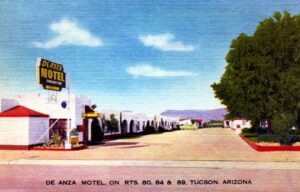Cover photo courtesy of Richard Marcoux via Facebook.
Back in the 1940s, traversing the nation by road meant no interstates. Instead, that meant taking two-lane highways that wound their way through small towns and big cities alike. That also meant there were no exits nor were there big name motel chains or fast food franchises dotting the American roadside.
Whether you were headed east or west, if you were driving through the Southwest, chances are you’d be taking Highway 80 through Tucson, Arizona. Chances are better that if you happen to be driving through there around nightfall, you’d likely be staying at the one of the many mom and pop motels along Tucson’s Miracle Mile.
The Miracle Mile
In 1937, the City of Tucson began a $200,000 highway improvement project that included creating a center median and a stream-lined traffic circle at each end of the strip. Arizona Magazine dubbed it “The Miracle Mile” and the stretch of roadway would fast become the northern gateway into “the Old Pueblo”.

It would also became everything related to mid-20th century car culture – gas stations, restaurants, drive-in movies, bowling alleys, car dealerships, nightclubs and mom and pop motels with adventurous and exotic-sounding names in big neon letters.
The No-Tel Motel
One of those motels was the mid-century modern Spanish Revival-styled De Anza Motel. Owned and managed by the Lambos family, their beautifully furnished rooms featured vented Panel Ray heating, air cooling, and tiled showers. Some even included kitchenettes.
Like it was for many families who set up roadside shops in those early days of road travel, we imagine that the motel was a pretty good business for the Lamboses for quite a few years. However, also like many mom and pop businesses around the country, that would all change starting in 1956 with Eisenhower’s Federal-Aid Highway Act of 1956 (FAHA) also known as the National Interstate and Defense Highways Act.
A year after FAHA was passed, the federal government started building Interstate 10 alongside the Santa Cruz River in 1957. While it was being built, the interstate had four exits into Tucson, one of which led to the Miracle Mile. However, once it was completed, I-10 would bypass all of the old highways travelers used to take on their way out West. As a result, traffic just stopped coming through and mom and pops started closing up one by one.

By the end of the 1960s, the Miracle Mile had become a seedy neighborhood full of sex workers, peep shows and porn shops. Families sold their once flashy and mid-century modern motels that offered respite for the night for the weary traveler to new owners who offered rooms-by-the-hour. Such was the fate of the De Anza Motel, whose new owners changed its name to the tongue-in-cheek “No-Tel Motel”. (The term “No-Tell Motel” was used for sordid motels that offer anonymity for sexual encounters.)
By the 1980s, the area had become a decrepit neighborhood known for sex, drugs, and crime.
Miracles by the Mile
A few years ago it seemed that truly only miracle could save the area – and that’s what happened.
In 2017, the Miracle Mile was placed on the National Register of Historic Places. As a result, the City of Tucson has started big redevelopment plans along the stretch of road where a neon glow once beckoned weary travelers.
As part of those plans, the city bought the No-Tel Motel for $825,000 last August. They plan on eventually converting the motel into affordable housing for seniors.
They’ve even decided on a new name – “Milagro on Oracle”.
Do tell!
—
It won’t exactly take a miracle to get hands on some delicious Stuckey’s treats these day, but it will take a little patience. Right now, we’ve put a halt on all orders on our website until February 20th as we transfer to a bigger, better warehouse so we can bring you even more delicious Stuckey’s products in the future.
However, we just look at this time as an excuse for you to take a road trip to your nearest Stuckey’s for Valentine’s Day treats, road trip snacks, and Stuckey’s branded clothing and other merchandise. (Of course, while you’re there, you might as well go ahead and pick up some kitschy souvenirs to remember your trip by.)
What’s more, you can still find your nearest Stuckey’s by visiting our store’s website located here.
In the meantime, you can also keep yourself entertained here on our Stuckey’s Pecan Blog Roll until then.
Stuckey’s – We’re Making Road Trips Fun Again!
Whether your next road trip is by car or by rail, it’s not really a road trip without taking Stuckey’s along. From our world famous Stuckey’s Pecan Log Rolls to our mouthwatering Hunkey Dorey, Stuckey’s has all the road trips snacks you’ll need to get you where you’re going.
For all of the pecany good treats and cool merch you’ll need for your next big road adventure, browse our online store now!
Stuckey’s – We’re Making Road Trips Fun Again!
